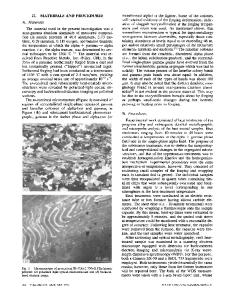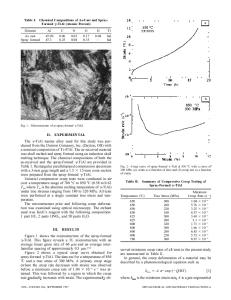Dynamic Fracture Initiation Toughness of a Gamma (Met-PX) Titanium Aluminide at Elevated Temperatures
- PDF / 1,102,139 Bytes
- 13 Pages / 593.972 x 792 pts Page_size
- 6 Downloads / 353 Views
INTRODUCTION
THE design of structures against catastrophic failure requires knowledge of the dynamic fracture of the materials of interest over a wide range of loading rates and service temperatures. The material properties of interest include dynamic crack initiation toughness and crack propagation and arrest. In particular, for aerospace applications, events such as soft foreign object damage (bird strike), hard foreign object damage (debris), and engine fan blade containment during catastrophic failure due to bird ingestion, etc., involve both high loading rates and elevated temperatures and require detailed knowledge of the dynamic fracture behavior of the materials in the system under consideration. Gamma titanium aluminides are being evaluated by the aerospace industry as candidate structural materials to replace the nickel-based superalloys. However, poor ductility and low fracture toughness have remained the primary roadblocks working against full utilization of these alloys. In this regard, over the last decade, a large number of studies have been performed to evaluate the dynamic fracture toughness of various candidate MOSTAFA SHAZLY, Graduate Student, and VIKAS PRAKASH, Professor of Mechanical and Aerospace Engineering, are with the Department of Mechanical and Aerospace Engineering, Case Western Reserve University, Cleveland, OH 44106-7222. Contact e-mail: vikas. [email protected]. SUSAN DRAPER, Research Staff Member, is with the United States National Aeronautics and Space Administration Glenn Research Center, Cleveland, OH 44135. Manuscript submitted November 1, 2006. Article published online April 14, 2009 1400—VOLUME 40A, JUNE 2009
gamma titanium aluminides. The results of these studies have provided information valuable in relating their dynamic fracture toughness to their chemical composition[1–3] and microstructural features.[2–7] In the recent past, the majority of the research on these alloys has focused on determining the quasistatic fracture toughness; the dynamic fracture of these alloys has been studied by relatively few researchers. Enoki and Kishi[8] investigated the effect of the loading rate on the fracture toughness in fully lamellar and duplex Ti-48Al (atomic percent) microstructures using a Charpy impact testing machine. They also investigated the relationship between dynamic fracture toughness, grain size, and the volume fraction of the c phase. The fracture toughness was found to decrease with increasing colony size and to increase with an increasing volume fraction of the c phase. Sun et al.[9] studied the fracture toughness of precracked three-point-bend specimens of Ti-45Al-1.6Mn (atomic percent) at impact velocities up to 10 m/s in a servohydraulic test machine. They reported a fracture toughness of approximately 25 MPaÆm1/2, which was independent of the impact speed. At high strain rates and elevated temperatures, Matsugi et al.[10] studied the Charpy impact properties at elevated temperatures for two different types of spark-sintered Ti-53Al (atomic percent) microstructures. The
Data Loading...











